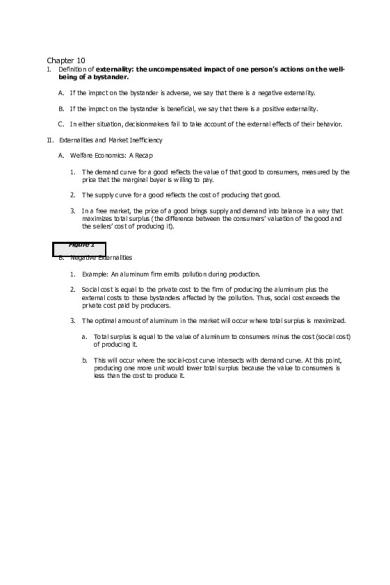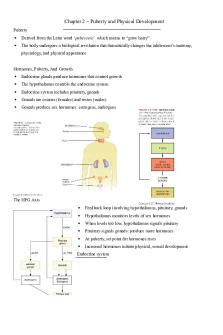Chapter 10 - David Johnson PDF

| Title | Chapter 10 - David Johnson |
|---|---|
| Author | Sivani Manchu |
| Course | Microeconomics |
| Institution | University of Wisconsin-Madison |
| Pages | 6 |
| File Size | 235.6 KB |
| File Type | |
| Total Downloads | 102 |
| Total Views | 157 |
Summary
David Johnson ...
Description
Chapter 10 I.
Definition of externality: the uncompensated impact of one person’s actions on the wellbeing of a bystander. A. If the impact on the bystander is adverse, we say that there is a negative externality. B. If the impact on the bystander is beneficial, we say that there is a positive externality. C. In either situation, decisionmakers fail to take account of the external effects of their behavior.
II. Externalities and Market Inefficiency A. Welfare Economics: A Recap 1. The demand curve for a good reflects the value of that good to consumers, measured by the price that the marginal buyer is willing to pay. 2. The supply curve for a good reflects the cost of producing that good. 3. In a free market, the price of a good brings supply and demand into balance in a way that maximizes total surplus (the difference between the consumers’ valuation of the good and the sellers’ cost of producing it).
Figure 1 B. Negative Externalities 1. Example: An aluminum firm emits pollution during production. 2. Social cost is equal to the private cost to the firm of producing the aluminum plus the external costs to those bystanders affected by the pollution. Thus, social cost exceeds the private cost paid by producers. 3. The optimal amount of aluminum in the market will occur where total surplus is maximized. a. Total surplus is equal to the value of aluminum to consumers minus the cost (social cost) of producing it. b. This will occur where the social-cost curve intersects with demand curve. At this point, producing one more unit would lower total surplus because the value to consumers is less than the cost to produce it.
Figure 2
4. Because the supply curve does not reflect the true cost of producing aluminum, the market will produce more aluminum than is optimal. 5. This negative externality could be internalized by a tax on producers for each unit of aluminum sold. 6. Definition of internalizing an externality: altering incentives so that people take account of the external effects of their actions. 7. In the News: The Externalities of Country Living a. In The Lorax by Dr. Seuss, urbanization is criticized while country living is considered more environmentally friendly. b. This article from The New York Times describes research that suggests that city living may in fact be “greener” because of the use of public transportation. C. Positive Externalities 1. Example: education. 2. Education yields positive externalities because better-educated voters lead to a better government. Crime rates also drop as the education level of the population rises. 3. In this case, the demand curve does not reflect the social value of a good. 4. If there is a positive externality, the social value of the good is greater than the private value, and the optimum quantity will be greater than the quantity produced in the market. 5. To internalize a positive externality, the government could use a subsidy.
Figure 3
6.
Case Study: Technology Spillovers, Industrial Policy, and Patent Protection a. A technology spillover occurs when one firm’s research and production efforts impact another firm’s access to technological advance. b. It is difficult to measure the amounts of technology spillover that occur and this leads to a debate over whether or not the government should pursue policies to encourage the production of technology. c.
Patent protection is a type of technology policy of the government because it protects the rights of inventors who create new technologies. Without patents, there would be less incentive to develop new ideas and technologies.
III. Public Policies toward Externalities A. When an externality causes a market to reach an inefficient allocation of resources, the government can respond in two ways. 1. Command-and-control policies regulate behavior directly. 2. Market-based policies provide incentives so that private decisionmakers will choose to solve the problem on their own. B. Command-and-Control Policies: Regulation 1. Externalities can be corrected by requiring or forbidding certain behaviors. 2. In the United States, the Environmental Protection Agency (EPA) develops and enforces regulations aimed at protecting the environment. 3. EPA regulations include maximum levels of pollution allowed or required adoption of a particular technology to reduce emissions. C. Market-Based Policy 1: Corrective Taxes and Subsidies 1. Externalities can be internalized through the use of taxes and subsidies.
2. Definition of corrective tax: a tax designed to induce private decisionmakers to take account of the social costs that arise from a negative externality. a. These taxes are preferred by economists over regulation, because firms that can reduce pollution with the least cost are likely to do so (to avoid the tax) while firms that encounter high costs when reducing pollution will simply pay the tax. b. Thus, this tax allows firms that face the highest cost of reducing pollution to continue to pollute while encouraging less pollution over all. c.
Unlike other taxes, corrective taxes do not cause a reduction in total surplus. In fact, they increase economic well-being by forcing decisionmakers to take into account the cost of all of the resources being used when making decisions.
3. Case Study: Why Is Gasoline Taxed So Heavily? a. In the United States, almost half of what drivers pay for gasoline goes to gas taxes. b. This is to correct for three negative externalities associated with driving: congestion, accidents, and pollution. D. Market-Based Policy 2: Tradable Pollution Permits 1. Example: EPA regulations restrict the amount of pollution that two firms can emit at 300 tons of glop per year. Firm A wants to increase its amount of pollution. Firm B agrees to decrease its pollution by the same amount if Firm A pays it $5 million. 2. Social welfare is increased if the EPA allows this situation. Total pollution remains the same so there are no external effects. If both firms are doing this willingly, it must make them better off. 3. If the EPA issued permits to pollute and then allowed firms to sell them, this would also increase social welfare. Firms that could control pollution most inexpensively would do so and sell their permits, while those who encounter high costs when reducing pollution would buy additional permits.
Figure 4
4. Tradable pollution permits and corrective taxes are similar in effect. In both cases, firms must pay for the right to pollute. a. In the case of the tax, the government basically sets the price of pollution and firms then choose the level of pollution (given the tax) that maximizes their profit. b. If tradable pollution permits are used, the government chooses the level of pollution (in total, for all firms) and firms then decide what they are willing to pay for these permits. E. Objections to the Economic Analysis of Pollution 1. Some individuals dislike the idea of allowing companies to purchase the right to pollute. 2. Economists point out that “people face trade-offs” (Principle #1) and we must decide how much we would be willing to give up in exchange for no pollution. It would likely not be enough. 3. A clean environment can be viewed as any other good that obeys the law of demand. The lower the price of environmental protection, the more the public will want. F. In the News: What Should We Do about Climate Change? 1. Many policy analysts believe that taxing carbon is the best approach to dealing with global climate change.. 2. This article from The New York Times explains how the revenue-neutral carbon tax works in British Columbia and argues for its implementation in the United States.. IV. Private Solutions to Externalities A. We do not necessarily need government involvement to correct externalities. B. The Types of Private Solutions 1. Problems of externalities can sometimes be solved by moral codes and social sanctions. a. Do not litter. b. The Golden Rule 2. Many charities have been established that deal with externalities. The government encourages this private solution by allowing a deduction for charitable contributions in the determination of taxable income. a. Sierra Club (environment) b. University Alumni Association (scholarships) 3. The parties involved in this externality (either the seller and the bystander or the consumer and the bystander) can possibly enter into an agreement to correct the externality.
C. The Coase Theorem 1. Definition of Coase theorem: the proposition that if private parties can bargain without cost over the allocation of resources, they can solve the problem of externalities on their own. 2. Example: Dick owns a dog Spot who disturbs a neighbor (Jane) with its barking. a. One possible solution to this problem would be for Jane to pay Dick to get rid of the dog. The amount that she would be willing to pay would be equal to her valuation of the costs of the barking. Dick would only agree to this if Jane paid him an amount greater than the value he places on owning Spot. b. Even if Jane could legally force Dick to get rid of Spot, another solution could occur. Dick could pay Jane to let him keep the dog. 3. Whatever the initial distribution of rights, the parties involved in an externality can potentially solve the problem themselves and reach an efficient outcome where both parties are better off. D. Why Private Solutions Do Not Always Work 1. Definition of transaction costs: the costs that parties incur in the process of agreeing and following through on a bargain. 2. Coordination of all of the interested parties may be difficult so that bargaining breaks down. This is especially true when the number of interested parties is large....
Similar Free PDFs

Chapter 10 - David Johnson
- 6 Pages

BPL 5100 Johnson& Johnson case
- 3 Pages

Chapter 2 - David Collins
- 10 Pages

BPL 5100 Johnson& Johnson case
- 5 Pages

Brian Johnson
- 2 Pages

Brian Johnson
- 7 Pages

Chapter 1 - Prof. David Rapien
- 5 Pages

Chapter 17 - David J. Doorey
- 2 Pages

Chapter 10 quiz #10
- 3 Pages

Notes 10 - Chapter 10
- 5 Pages

Philip Johnson
- 14 Pages
Popular Institutions
- Tinajero National High School - Annex
- Politeknik Caltex Riau
- Yokohama City University
- SGT University
- University of Al-Qadisiyah
- Divine Word College of Vigan
- Techniek College Rotterdam
- Universidade de Santiago
- Universiti Teknologi MARA Cawangan Johor Kampus Pasir Gudang
- Poltekkes Kemenkes Yogyakarta
- Baguio City National High School
- Colegio san marcos
- preparatoria uno
- Centro de Bachillerato Tecnológico Industrial y de Servicios No. 107
- Dalian Maritime University
- Quang Trung Secondary School
- Colegio Tecnológico en Informática
- Corporación Regional de Educación Superior
- Grupo CEDVA
- Dar Al Uloom University
- Centro de Estudios Preuniversitarios de la Universidad Nacional de Ingeniería
- 上智大学
- Aakash International School, Nuna Majara
- San Felipe Neri Catholic School
- Kang Chiao International School - New Taipei City
- Misamis Occidental National High School
- Institución Educativa Escuela Normal Juan Ladrilleros
- Kolehiyo ng Pantukan
- Batanes State College
- Instituto Continental
- Sekolah Menengah Kejuruan Kesehatan Kaltara (Tarakan)
- Colegio de La Inmaculada Concepcion - Cebu




